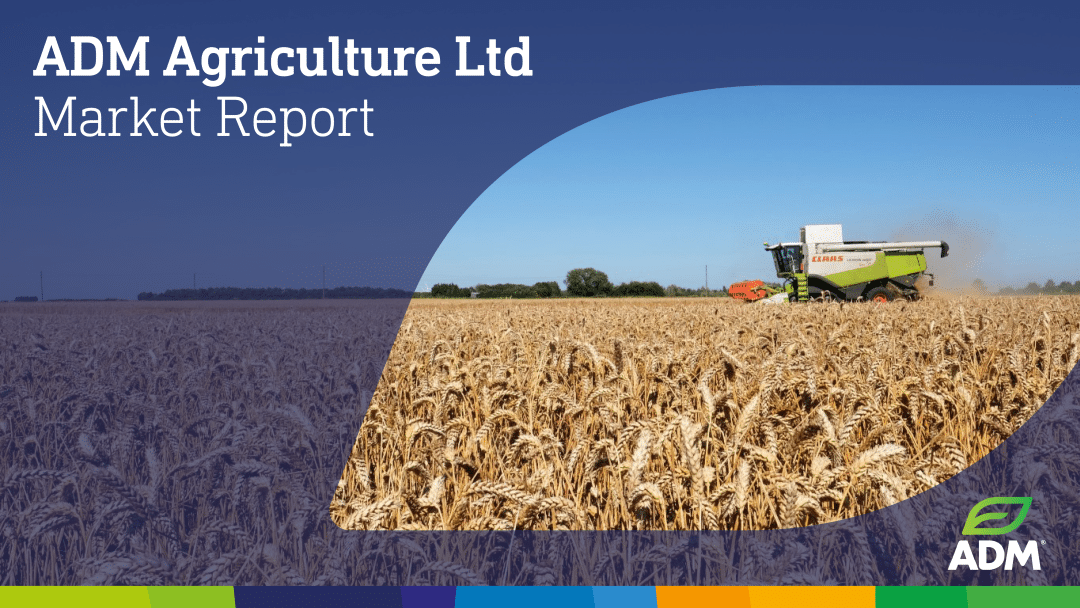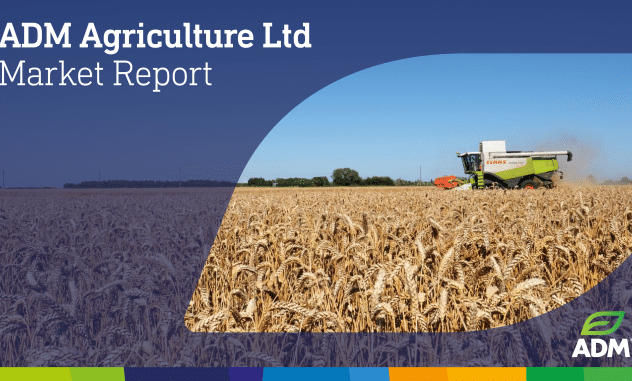WELCOME TO THE ADM AGRICULTURE WEEKLY MARKET REPORT
Wheat
- This week saw steady but marginal gains in global wheat markets as traders positioned themselves ahead of the upcoming USDA WASDE report. The Dec’24 CBOT wheat contract closed 5c/bu higher, marking a weekly high, driven largely by continued supply concerns in Russia due to adverse weather. Corn markets were more subdued, with the Dec’24 contract ending just 1c/bu in the green after a choppy session. Soybeans, however, faced significant pressure, closing down 20c/bu, which dragged corn lower early on.
- European wheat markets followed the upward trend, with MATIF wheat rebounding from support at €218/t and closing at a four-week high, up €3 on the day. In London, the Nov’24 wheat contract gained £2.60 to close at £184.80, while the May’25 contract saw further upward movement, finishing £1.25/t higher at £196.75.
- The Black Sea region remains a key focus in global wheat markets, with Russia’s supply chain facing significant disruption due to extreme weather. Heavy rain in Siberia, a major spring wheat-producing region, has prompted several areas to declare a state of emergency. Rostov, responsible for 11% of Russia’s grain harvest, expects a 30% drop in production this year due to early frost and drought. This raises concerns about Russia’s ability to meet its export targets. Adding to market jitters, the Russian president suggested potential restrictions on exporting key commodities, though grains were not specifically mentioned.
- Despite these issues, Ukraine’s grain exports are on the rise. Shipments have reached 8.2 million metric tons (mmt) this year, up from 5.4mmt in 2023, including 4.3mmt of wheat. Ukraine’s continued presence in the market, despite regional challenges, has helped alleviate some global supply concerns, although cheaper Black Sea exports continue to cap price gains in other regions.
- The upcoming USDA WASDE report is anticipated to provide clarity on global supply trends, with particular attention on U.S. corn and soybean yields. Expectations are for slight reductions in U.S. corn yields, down from 183 bushels per acre (bpa) to 182.4 bpa, though this still represents a robust crop. Soybean yield estimates are similarly strong, positioning the crop as a key performer in the U.S. agricultural sector. U.S. wheat ending stocks are expected to tighten slightly, providing support to wheat prices.
- Adverse weather in the U.S. has also played a role in shaping market sentiment. The remnants of Hurricane Francine are expected to bring much-needed rain to areas in the Midwest, including Indiana, Illinois, Tennessee, and Kentucky, though flooding concerns persist. The U.S. spring wheat harvest is progressing rapidly, with 85% completed compared to 70% at the same time last year.
- European wheat markets saw steady movement this week, with Matif wheat supported by firm technical levels and rising global concerns. EU soft wheat exports since July 1 have reached 4.8mmt, down 23% from last year, largely due to continued pressure from cheaper Black Sea wheat exports. As for the UK, farmers remain reluctant to sell, even as recent rains have improved soil moisture and created favourable conditions for planting next year’s crops. Consumer buying activity has been livelier, with wheat regaining market share as its prices at larger discounts to corn.
- Wheat markets remain firmly in bull territory, underpinned by concerns over tightening global supplies and weather-related issues in key production regions. The Russian supply situation continues to drive global wheat prices, and the USDA WASDE report on September 12 is expected to bring further clarity. Traders are closely watching developments in Russia and Ukraine, as well as the expected large U.S. crops. While current momentum is strong, there is some speculation that the market could shift after the report, potentially leading to profit-taking once the full supply picture is revealed.
- In the UK, cash markets have been quieter, with premiums driving market activity as basis increases have failed to draw in farmer sellers. Despite good planting conditions, the reluctance of UK farmers to engage with the current market has kept supply relatively tight.
- Overall, while global wheat supply concerns persist, particularly from the Black Sea region, markets are cautiously optimistic, but the longer-term outlook depends heavily on upcoming USDA data and further developments in Russia and Ukraine.
Barley
- Feed barley continues to prove a challenging product of late with consumers starting to switch across to cheaper alternatives.
- The UK farmer-seller remains uninterested in grain marketing and as a result basis has and continues to be squeezed tighter.
- Export channels remain firmly off the table still with Irish bids significantly undercutting delivered mill values domestically.
- Everything is now about timing and if we see growers return to the market, basis and flat prices could come under pressure.
- Until that happens, domestic bids are sporadic and mainly merchant shorts in the spot with forward runs largely off the table.
- Spring barley harvest in England, in the main is all in the barn bar a few parcels and makes good quality malting spec. Scotland is slow to start, and quality remains to be seen.
- For another week we see very quiet markets on malting barley with consumers completely absent.
- Growers remain slow to engage and markets continue to drift, premiums are squeezed on the back of firm feed barley values.
Rapeseed
- Ag markets have been choppy this week as the trade adds weather premium into prices due to continued dryness in the US as well as position squaring ahead of this week’s USDA WASDE report. Last week’s export sales came in at a total of 1,430,738 mt for both marketing years and have now reached 23.8% of the USDA’s forecast for 24/25 vs. last year’s 29.9%. Crop conditions came in unchanged week on week, despite expectations for a 1% drop. Good/Excellent ratings now sit 3% above the 10-year average. China has continued to improve its coverage this week with another 132,000mt of sales. USDA expectations are for a slight yield and production increase with US ending stocks higher and world stocks close to unchanged.
- In Brazil, Safras have pegged new crop soybean farmer selling at 22% vs. 17.9% this time last year. ANEC has forecasted exports to reach 5.5 mmt vs. 5.63 mmt in their previous forecast. In Argentina, soy plantings are climbing to the demise of corn as farmers switch due to dry weather and fears of disease. Plantings are currently 7.5% higher than last year.
- Energy markets have been sharply lower so far again this week as the continued concern over Chinese demand offsets oil platform shutdowns due to Hurricane Francine. We have seen China’s daily crude imports rise to a 1 year high on lower prices though total shipments for the month were down 7% year on year as low fuel consumption kept demand capped. Analysts have said that China’s annual oil demand growth has slowed from 500,000-600,000 barrels per day to 200,000 now due to the adoption of electric vehicles and trucks.
- Canola prices have been choppy this week and remain towards the bottom end of the price range as weaker world energy pricing alongside heavy canola stocks continue to weigh on prices. This has allowed margins to recover though, with China not happy prices will struggle to find demand. As it stands Canola will be able to fill the gap in the EU S&D before the Australian harvest arrives. 23/24 ending canola stocks for July 24 are expected at 2.925 mmt, nearly double the previous year. China’s Ministry of Commerce announced this week that their investigation into Canada’s canola dumping is expected to take up to a year with a deadline of 9th Sept 2025. This suggests that Chinese tariffs will not be imposed any time soon.
- MATIF rapeseed has also been mixed this week with canola prices at a high of $94 so MATIF prices remain a follower. We have not seen the seasonal drop that we would expect to the extent we usually do, though heading into next week this starts to level out. We remain in a place where we need to find a direction to go forward so the key will be this week’s USDA alongside developing weather events.
Oats
- European oat markets continue to see negative price action with prices easing further week on week.
- Some wet weather has delayed some of the Finnish oat crop and this could see some poor quality in what is left in the field.
- Demand generally remains slow with minimal trades being reported; however, some direct business may be taking place which doesn’t appear in the market.
- Feed oats remain very hard to sell and with no demand into Spain right now, poor-grade oats will need to work harder to feature in feed rations vs other feed grains.
- Here in the UK milling oat prices continue to fall with millers bidding prices lower for spot movement. This is putting the UK at one of the cheapest origins which could open the way for exports in the weeks to come.
- Quality from samples that we have seen to date through ADM’s lab remains good and this is largely the way we are seeing milling prices continue to remain under pressure.
- Bottom line, oat prices have fallen significantly over the last few weeks, and this should start to draw out some buying demand.
Pulses
- Two weeks ago it was warm and sunny, last week it was cool and grey, this week it is down-right cold – at this rate, the daffodils will be out, and spring will have sprung next week… Despite the apparent rapid changing of the seasons, beans continue to be cut around the UK, but plenty are still left standing in the fields. Some of our more experienced readership will potentially remember some people who used to say, as long as the pods were intact, that they wouldn’t touch Springs until they’d had a frost on them. With plenty still left in the field, it is still on course to be a steady, protracted harvest. Markets have been about as active as the weather, with odd pieces of interest, however, people seem content to sit and watch this market for now.
- Our labs are still seeing samples a-plenty, and they’re still generally looking clean and well-threshed, with comparatively low levels of admix. In the week ahead standing crops still look reasonably well, and a steady flow of samples through our lab shows relatively low levels of admix and ‘clean threshing’. Looking to next week’s weather, expect temperatures to again be a couple of degrees below the seasonal norm, while southern England will be comparatively drier, mainly seeing light showers. Northern England is due rainfall, with up to 20mm on the cards for some in the northwest. Much of the Baltic, currently in the throes of harvesting beans, is seeing warmer-than-normal temperatures for the week ahead, although they will be hampered by 10-20mm of rainfall in the forecast.
- The quality of the samples that we are seeing come through the labs suggests there is the potential for a slight reprieve to the UK human consumption crop, something that has struggled in the last couple of years. With this in mind, it is very much in your interest to keep talking to your farm trader and pushing samples across if they look like they have potential, as we may be able to upgrade them for you and pay an additional premium if they hit spec. This, combined with the Baltic crops, looks like they might be stumbling slightly on quality for once, so there may be a window of opportunity for the UK market. Considering that feed beans are still not super-competitive against imported proteins, still needing to give c. £15/mt relative to other commodities, feed is only likely to come under further pressure and be squeezed lower.
- On the currency markets, GBPUSD is under pressure due to expectations of prolonged higher U.S. interest rates, with the pair currently hovering around the 1.30 level. With the US Presidential Election now less than 8 weeks away, it is also worth keeping an eye on what is going on ‘across the pond’, as there is some potential for additional volatility. Meanwhile, GBPEUR has stabilized above 1.17 (currently over 1.18), as speculation around a potential ECB rate cut, coupled with resilient UK economic data, provides support to GBP. Remember, crudely, strong GBP = cheaper imports/weak GBP = more aggressive exports.
- While the weather isn’t too inducive to fieldwork, the drilling window for winter pulses isn’t a million miles away. Now is a good time to talk to your farm trading representative about all things pulses! With a combination of some great marketing options, various seed stocks ready to go, and a portfolio of cost-effective inputs, such as P-Grow and FibroPhos, that can help push your yield potential, they are ready and happy to help. We are buyers across a wide spread of homes nationally, so we can offer you competitive origination markets, plus the opportunity to upgrade any crops that may be fit to human consumption pulses to be processed in one of the most advanced pulse processing plants in the UK and Europe, all whilst earning an additional premium for your crops.
- Finally, the ever-present PGRO plug to those eligible to be members. If you are not already signed up to the PGRO mailing list, you can sign up here where levy payers can access all sorts of advice and support, tapping into their extensive knowledge bank on all things pulses for free! The PGRO is a unique organisation within the UK, and if you are paying for it, you may as well use it!
Seed
- The demand for wheat seed has increased dramatically over the past week. As preparations for drilling begin, demand remains for the Group 1 & Group 2 varieties due to the excellent buy-back terms being available from ADM. If you’re still looking for seed to cover for a contract, please contact your local ADM farm trader before stocks run out.
- Good news this week from the UK flour millers confirming that the new milling wheat from Syngenta, SY Cheer, has now achieved full Group 1. We have limited stock available, so please give us a call. We still have limited amounts of the new Bamford Group 3 to offer, again with a very attractive buy-back contract.
- If oilseed rape is still on your mind, we have stocks in various places or can offer a next-day delivery service on select varieties.
- If you’re planning to use a winter cover this year, whether for grazing or soil health, contact your ADM farm trader to find the mix that best fits your needs. We also offer custom blends available upon request.
Fertiliser
- Following India issuing awards for 1.13MT in last week’s tender, the urea market has adopted a firmer tone and now remains overall supported.
- Granular prices in Egypt have risen by $ 15 t over last week as more demand from Europe and other areas continues to surface.
- Demand for nitrates remains low but with volumes traded to date across Europe below normal, there is a lot of business to be concluded at some point in Q4.
- CF Fertilisers still have a 34.5% Nitram price for December delivery in the marketplace. With gas and ammonia costs stuck at season highs, this offers an excellent buying opportunity.
- Phosphate prices have stabilised but speak to ADM on Fibrophos and other renewable PKs. Applied onto stubbles, these are a very cost-effective way of replenishing P and K values in the soil.
- Potash prices continue to trade sideways and are expected to remain little changed.
| £/€ | £/$ | €/$ |
|---|---|---|
| 1.1840 | 1.3049 | 1.1019 |
| Feed Barley £ | Wheat £ | Beans £ | Oilseed Rape £ | |
|---|---|---|---|---|
| Nov 24 | 160-170 | 175-190 | 215-225 | 390-395 |
NB: Prices quoted are indicative only at the time of going to press and subject to location and quality.
“Although ADM Agriculture take steps to ensure the validity of all information contained within the ADM Agriculture Market Report, it makes no warranty as to the accuracy or completeness of such information. ADM Agriculture will have no liability or responsibility for the information or any action or failure to act based upon such information.”
ADM Agriculture cannot accept liability arising from errors or omissions in this publication.
ADM Agriculture trade under AIC contracts which incorporate the arbitration clause.
Terms and Conditions of Purchase.
On every occasion, without exception, grain and pulses will be bought by incorporating by reference the terms & conditions of the AIC No.1 Grain and Peas or Beans contract applicable on the date of the transaction. Also, we will always, and without exception, buy oilseed rape and linseed by incorporating by reference the terms & conditions of the respective terms of the FOSFA 26A and the FOSFA 9A contracts applicable on the date of the transaction. It is a condition of all such transactions that the seller is deemed to know, accept and understand the terms and conditions of each of the above contracts.



